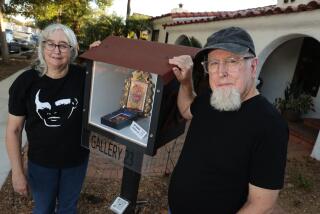Bringing respect to the craft artist: How one small museum does it, page by page
- Share via
Giving lesser-known artists visibility is key to the mission of the Craft and Folk Art Museum, says Executive Director Suzanne Isken, whose institution has an annual operating budget of about $730,000 — less than what some Hollywood stars make for a few days’ work.
Which is why a $25,000 grant from the National Endowment for the Arts has been so crucial for the L.A. museum to stage its current exhibition, “Chapters: Book Arts in Southern California.”
The exhibition features more than 100 altered and sculptural books, zines and artist-driven publications made since the 1960s. And a line-item breakdown of how the $25,000 and matching grant money were spent offers a window into the pricey but necessary minutiae associated with a museum exhibition — costs that the public may not consider.
Shipping art to and from the museum, for example, cost $800. Security for the show cost $1,200. Postcard printing and mailing cost $150. Three advertising spots on a local NPR station totaled $1,500. Lighting and painting supplies were $1,140. Insurance for the show was $1,200. The most expensive item on the list: $8,000 for fabrication of exhibition displays, as well as labels and wall text. Artist fees for all commissioned work totaled only $6,000.
“Our pay is very low,” Isken says regretfully.
They are very serious about these grants, and they really provide opportunities for artists.
— Suzanne Isken, executive director of the Craft and Folk Art Museum, on the National Endowment for the Arts
That show features the work of 55 artists, many of whom would otherwise not get their work seen, Isken says. The show represents the first large-scale museum survey cataloging the importance of Southern California artists on the development of book arts, she said.
“They are very serious about these grants, and they really provide opportunities for artists,” Isken says of the NEA, adding that 90% of the artists CAFAM features are emerging.
Whereas a larger museum can turn to luxury brands for sponsorships and maybe park a Jaguar on its plaza as advertising, smaller venues don’t carry that kind of prestige. Individual gifts also can be harder to come by.
“There’s not a lot of social standing in the smaller organizations, it doesn’t give you that cache,” Isken says with a laugh.
The result is a frugal operation where every dollar counts. A curator might make less than $60,000 per year, and part of that salary could be paid by an NEA grant for a particular show. In the case of “Chapters,” curator Holly Jerger received $5,400 thanks to the NEA.
“We thought we could do this show for $50,000,” Isken says, citing the total of the NEA grant and the matching funds the museum raised. “For us that’s a huge show, for others that’s not so much.”
CAFAM has received a total of $55,000 from the NEA in the form of four grants since 2010. A $10,000 grant in 2014 was used to support an exhibition of work by the beloved local sculptor Clare Graham; the exhibition was accompanied by sculpture workshops for developmentally disabled adults. The results of those workshops were exhibited along with Graham’s work.
“It meant so much to these artists and their support groups to come and see their work on display,” Isken says.
The attention that comes with a CAFAM show has helped to launch careers. In 2015, the museum exhibited the far-out creations of shoe artist and designer Chris Francis, elevating his national profile. The following year Vogue wrote an article on Francis, touting his six-month residency crafting shoes at CAFAM.
“These are people we’ve helped expose, and then other people hear about them, and that’s how it happens,” says Isken, circling back to “Chapters,” which features the work of many women and artists of color who found their artistic voices via book arts at a time when the broader art world was often shut off to them.
“It was a way to express themselves,” she says, “and get shown when they couldn’t get seen in museums.”
“L.A. Without the NEA” is a series looking at a different community group, how its NEA funds were spent, what artistic or public good did or didn’t result and what the cultural landscape would look like if that program were to disappear. Look for more installments to follow at latimes.com/LAwithouttheNEA.
ALSO:
The NEA works. Why does Trump want to destroy it?
Lin-Manuel Miranda’s ‘Hamilton,’ as vital as ever, opens in San Francisco
Robert Schenkkan’s ‘Building the Wall,’ set in Trump’s America
More to Read
The biggest entertainment stories
Get our big stories about Hollywood, film, television, music, arts, culture and more right in your inbox as soon as they publish.
You may occasionally receive promotional content from the Los Angeles Times.











